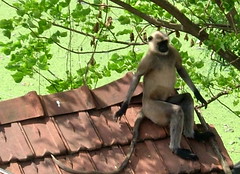H is for HANUMAN
Recently this langur paid a visit to the rooftop just below our apartment. A man had fed him a banana and he was waiting to see what else he might get.
The Hanuman langur is a revered monkey god that dwells from the Himalayan mountains through the semi-arid zones of Rajasthan to the cultivated plains of the Ganges. While Hindus often consider these primates to be incarnations of the monkey god Hanuman, a key player in The Ramayana, an epic story central to Indian culture, biologists call them variously grey langurs, Hanuman langurs or Indian langurs. They are equally at home in Indian cities as in the tropical forests of Sri Lanka, the ancient battle-place of The Ramayana.
The story of Hanuman
When the demon king abducted Rama's wife Sita to the island of Lanka, Hanuman lead an army of monkeys to rescue her. Halfway through the saga, demons capture Hanuman, wrap his tail with oil-soaked cloths and set it on fire. The noble monkey escapes and drags his torched tail across the roofs of Lanka, burning the villain's residence to ashes. The charcoal-black feet, hands and faces of today's temple monkeys are testimony to this heroic dash.
The Hanuman langur is a revered monkey god that dwells from the Himalayan mountains through the semi-arid zones of Rajasthan to the cultivated plains of the Ganges. While Hindus often consider these primates to be incarnations of the monkey god Hanuman, a key player in The Ramayana, an epic story central to Indian culture, biologists call them variously grey langurs, Hanuman langurs or Indian langurs. They are equally at home in Indian cities as in the tropical forests of Sri Lanka, the ancient battle-place of The Ramayana.
The story of Hanuman
When the demon king abducted Rama's wife Sita to the island of Lanka, Hanuman lead an army of monkeys to rescue her. Halfway through the saga, demons capture Hanuman, wrap his tail with oil-soaked cloths and set it on fire. The noble monkey escapes and drags his torched tail across the roofs of Lanka, burning the villain's residence to ashes. The charcoal-black feet, hands and faces of today's temple monkeys are testimony to this heroic dash.


0 Comments:
Post a Comment
Subscribe to Post Comments [Atom]
<< Home